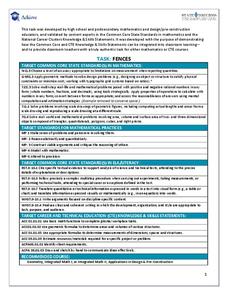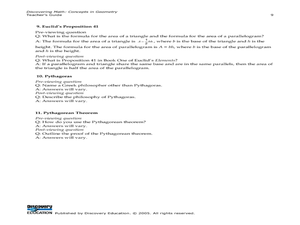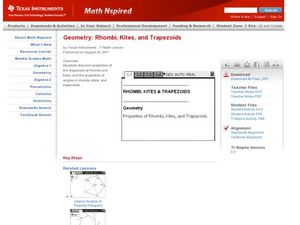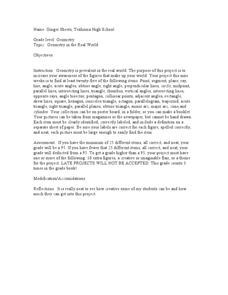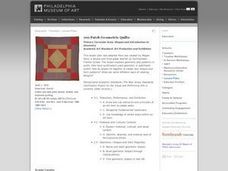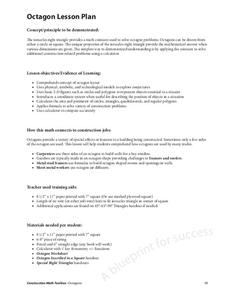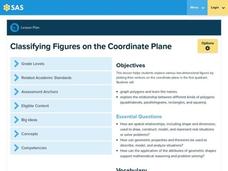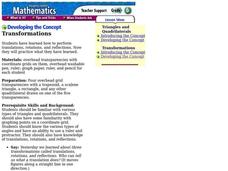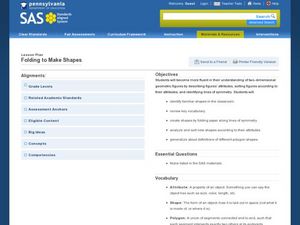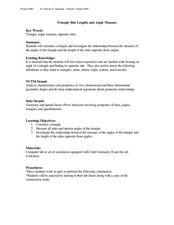Noyce Foundation
Which is Bigger?
To take the longest path, go around—or was that go over? Class members measure scale drawings of a cylindrical vase to find the height and diameter. They calculate the actual height and circumference and determine which is larger.
Achieve
Fences
Pupils design a fence for a backyard pool. Scholars develop a fence design based on given constraints, determine the amount of material they need, and calculate the cost of the project.
Pennsylvania Department of Education
Problem Solving with Fractions
Solve story problems using fractions or decimals. Then, determine the reasonableness of answers using estimation.The detailed lesson includes essential questions, vocabulary, a materials list, and links to related units.
Curated OER
Building Bridges
Learners identify the different types of bridges. Using the internet, they research information on how they are built by completing a scavenger hunt. Locating a specific area, they determine which type of bridge would be appropriate and...
Curated OER
Discovering Math: Concepts in Geometry
Middle and high schoolers explore the concept of proving the Pythagorean Theorem. They research proofs of the Pythagorean Theorem. Pupils create posters of proofs, and research Greek mathematicians.
Think Map
Know Your Polygons!
Shape shifters recognize characteristics of polygons. Embracing language arts skills in addition to math, they use a thesaurus to pinpoint specific attributes of a set of polygons. They also participate in a 21-question guessing game...
Curated OER
Circles and Angles
Students identify tangents, chords and secants. In this geometry lesson, students graph circles and identify angles created by secant lines, tangent lines and chords.
Pennsylvania Department of Education
A Geometric Scavenger Hunt
Fifth graders connect their knowledge of polygons and polyhedrons. For this geometric shapes lesson, 5th graders identify and classify two- and three-dimensional objects. Students construct a polyhedron out of polygons and describe their...
Curated OER
Rhombi, Kites, and Trapezoids
Students identify the number of diagonals for each polygon. For this geometry lesson, students identify the polygons based on their diagonals and the way it intersect. They create visuals using the navigator to see the changes in the...
Curated OER
Geometry in the Real World
Eighth graders complete a unit of lessons on basic geometry concepts. They participate in a variety of activities, culminating in a project that involves publishing a booklet or a poster that presents the major geometry concepts from the...
Curated OER
100 Patch Geometric Quilts
Students identify geometric patterns in quilts. In this geometry instructional activity, students view various types of quilts and identify the geometric shapes. Students construct one hundred patch paper quilts using geometric shapes.
Curated OER
Areas of Trapezoids, Rhombuses and Kites
Students calculate the area of different polygons. For this geometry lesson, students find the area for trapezoids, rhombuses and kites.
Curated OER
Multiplying Polynomials
Students explore the concept of multiplying polynomials. In this multiplying polynomials instructional activity, students watch a video clip about basic math skills. Students work in groups on an exploration about why a binomial squared...
Texas Instruments
Construction Regular Polygons
Learners investigate the process necessary to construct regular polygons. They explore the degree measures of the angles in a regular polygon. Using this information and technology in the form of Cabri Jr., your pupils will construct...
Curated OER
Triangle Island
Students calculate the altitude of triangles. In the web based lesson plan, students explore the interior distance from a given point in a polygon to its side. They compute the sum of these lengths. Students read life...
Curated OER
Geometry and Spatial Sense
Students investigate geometric shapes in 2 and 3 dimensions. In this geometry lesson, students create a model chocolate factory working in groups and using an actual cake. Students take a quiz about measurement equations...
Curated OER
Octagon Lesson Plan
Students investigate octagons using words and shapes. In this geometry lesson plan, students discuss the shape of an octagon using physical and symbolic models. They make conjecture about the shape and relate it to the real world.
Pennsylvania Department of Education
Classifying Figures on the Coordinate Plane
Fifth graders use estimation to solve word problems. In this fractions lesson, 5th graders decide whether or not an answer to a work problem is reasonable by applying their knowledge of fractions, decimals and estimation. This lesson...
Curated OER
Regular Polygons
Fifth graders explore polygons. In this math instructional activity, 5th graders find examples of regular polygons in the classroom and measure the sides of figures to determine if they are regular polygons.
Curated OER
Transformations
Sixth graders discover transformations. In this graphing lesson, 6th graders explore visual examples of plotting transformations as they review translations, rotations, and reflections. Students also practice solving problems that their...
Curated OER
Problem Solving Using Power Polygons
Students investigate geometric shapes by creating figures on a plane. In this polygon lesson, students complete a worksheet based on the angles in a power polygon. Students identify the different types of polygons and define their...
Curated OER
Designing a Quilt Pattern
Students create and color a one-patch quilt design based upon a regular hexagon. They examine quilts and photos of quilt designs, read a handout, and complete their quilt design on a worksheet.
Curated OER
Folding to Make Shapes
Second graders identify different polygons and their attributes. In this geometry lesson, 2nd graders get to know polygons by studying the vocabulary and finding polygons in their classroom. They create these shapes and then find their...
Curated OER
Triangle Side Lengths and Angles Measures
Students identify missing sides and angles. In this geometry lesson, students use triangular theorems to identify the missing sides. They use the Pythagorean Theorem to find the different ratios of each side.

